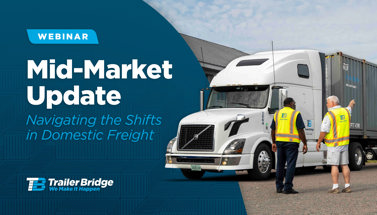
Navigating the Current Market of Contract vs. Spot Freight
The freight market has experienced a rollercoaster of economic conditions and industry analysts are calling for the same as we enter the second half of 2022.
Preparation is a key component for freight company strategies and growth. Historically, organizations have been able to prepare for seasonality around things like produce peak season, back to school, or the holidays, however today’s market is still quite unpredictable.
Navigating today’s trends and selecting the right shipping option can be an undertaking. Here, we break down what’s going on in the industry but first let’s define contract freight and spot freight and look at the advantages for shippers.
A contract rate is a fixed price the carrier or 3PL agree on to move a shipper’s freight over a set period of time. Additionally, it is typically the same type of freight each time. Most contracts average a duration of six months to a year.
Spot Rates are for shippers without carrier contracts but have freight to move. These rates are based upon market conditions and therefore can change daily. Spot rates may also be used when shippers are seeking more capacity outside of their contract terms.
Advantages for Shippers
Each option has their pros and cons. The biggest advantage to having a contract is that the shipper knows that their rate will not change should the market experience an increase in pricing. This avenue for freight allows for easier budgeting and forecasting, ability to build strategic carrier relationships, and transparency with their supply chain with KPI reporting from the carrier. On the flipside, should the market rate decrease, the shipper will remain paying the higher contracted price until the renewal period.
For shippers that depend on spot pricing, the biggest pain point occurs with budgeting and planning – it becomes more difficult. While shippers can have an idea of what the year will look like, it will only be an estimate and very rarely be optimal. On the other hand, for shippers seeking a last-minute move or just wanting a quick response, receiving a spot rate will be much faster over negotiating a contract.
Current Market Trends
The second half of 2021 and moving into 2022, the market was riddled with tight equipment capacity and a rush to restock inventories, causing shippers to lock in freight contracts. As we now enter the third quarter, the market is fluctuating again. A recent Wall Street Journal article reported “trucking rates are declining largely because of a shift away from the spot market toward longer-term contract rates as truckers see more stability in their routes.” With the move away from spot, carriers are seeing the contract marketplace remain steady with customers preferring contracted rates over spot. Shippers want that sense of secured pricing but are preferring a shorter contract time period.
According to DAT, Trucking spot rates have fallen 26% since June of last year. As of June 2022, the average contract rates were approximately 17 cents higher than spot rates, but shippers are not benefitting just yet. With fuel and diesel prices at an all-time high in decades, fuel surcharges are eliminating the savings shippers gained with lower spot prices. The media is predicting a recession, but industry experts think otherwise. “We’re living through historic chaotic times,” said Eric Masotti, President of Logistics at Trailer Bridge. “The drop of spot rates after two years of sky-high prices has potentially heightened the senses of shippers, but we’re not seeing a slowdown for demand in service.”
It appears the spot market is shifting closer to pre-pandemic norms and are not actually an indicator of a recession. Spot demand is still above historic averages but lower than what the market experienced at the height of the pandemic. DAT principal analyst Dean Croke told Transport Topics “We are returning back to more normal freight market behavior and seasonality is kind of re-emerging albeit a little bit different. We haven’t seen that strong return to seasonality because spot rates aren’t going up in the four weeks before July 4, which they normally do.”
As we prepare for peak season this fall and winter along with the backlog of vessels coming in from Asia, no one can predict what the market will do. Uncertainty remains on both the demand and supply sides. Trucking companies will continue to do what they’ve been doing for the past two years which is remain flexible while the market conditions vary month to month. “We’ll continue to pass through savings to our customers wherever we can,” said Masotti. “Only time will tell how the market plays out, but we’ll be ready for whichever way it does.”
This is a key reason why relationships matter. Building a strong relationship with your logistics provider opens communication and builds trust. That thought is true in your personal life and is essential in your supply chain. Having that reliable, predictable information and service at your fingertips is invaluable. Think of Trailer Bridge as an extension of your in-house team – we’re here to help guide you every step of the way.




